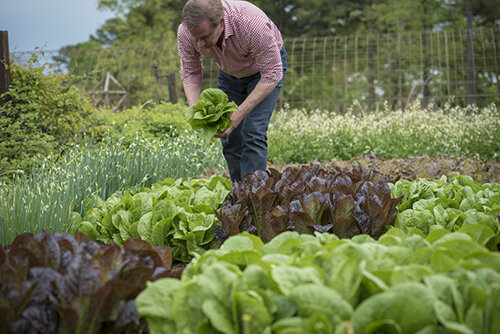When we decide to start a garden, we often think about planting seeds or seedlings. Did you know that you can also start a little veggie garden with scraps from your dinner prep? The bottoms of celery, onions, and other veggies and herbs that usually end up in the trash just need a little TLC to take on a new life of their own.
- Celery – Place the root end of the celery in a shallow bowl of water. You want just enough water to cover the roots, and you should replace the water daily. Place the bowl in a sunny spot. You should see new leaves and roots appear in about a week, at which point you can transfer the celery to the soil. Make sure you do not cover the new leaves with soil.
Celery requires lots of water. Even when the cutting is in the bowl of water, you may need to mist it to keep it moist. Once it’s planted, you can use compost and mulch to help retain moisture around the plants. - Romaine Lettuce – The same rules as celery apply for starting Romaine inside from a scrap. After a week or two, the cutting should be ready to go into the ground. Lettuce requires moist but well-drained soil. As with celery, mulch will help. With lettuce, it’s easy to determine how much water they need—if the leaves are wilting, give them water.
- Garlic – This is an easy one. All you need are a couple of cloves. In the fall, plant them in soil with the smaller, pointy end up. Make sure the container or bed receives plenty of sunlight. You should see shoots in a few weeks.
- Onions – Onions are another easy vegetable to propagate. Cut off the root end leaving a little bit of the onion intact. Place in a wide container at least 10 inches deep or in the raised bed or directly in the ground. The only real thing they demand is well-drained soil.
- Potatoes – When potatoes start growing eyes, they’re usually destined for the trash. Put those wrinkly tubers to good use instead of tossing them out. Cut the potatoes into sections, making sure each section has at least two eyes. Dry them out for a day or two then plant them in soil that’s been amended with compost in full sun.
- Ginger – It’s so nice to have fresh ginger lying around. I use it in cooking and when making tea at home. It may not be the easiest to grow, but it’s worth the effort. If you can get your hands on a piece from a friend who grows their own, that’s best. Otherwise, look for pieces of ginger at the grocery store that has growth buds—they look like tiny, nubby fingers.
I recommend soaking the piece of ginger overnight then planting it. Remember, ginger grows in the tropics, so it likes moist soil and humid conditions. It also makes a great houseplant! You can find more tips here about getting ginger plants started successfully! - Lemongrass – I love the citrus flavor of this tropical herb. To start new growth in your kitchen, place the root end of lemongrass in a glass or jar with enough water to cover the roots, then put it in a sunny area. You should see new growth in a week or so. At this point, you can transplant your lemongrass (I like to use a pot), keeping it in a sunny place. Lemongrass needs rich, well-drained soil.
Unless you are in Zone 8 or higher, lemongrass will not survive outside through the winter, so make plans to keep it inside.



